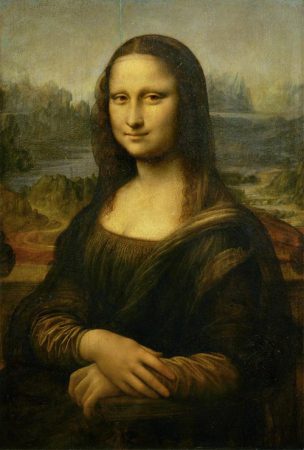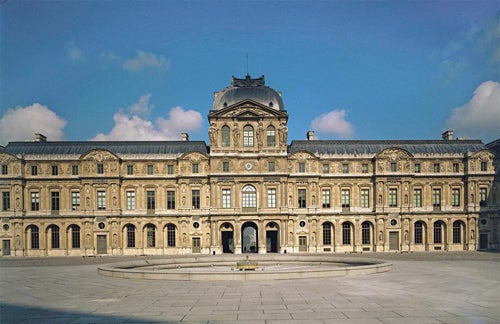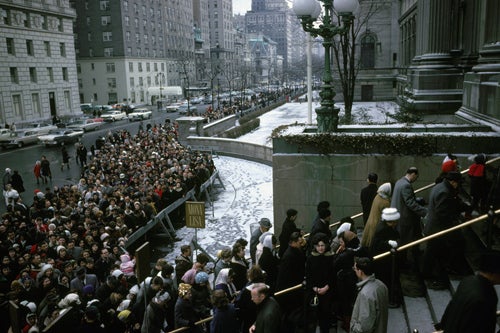The travels and travails of the Mona Lisa

Leonardo da Vinci, Mona Lisa, 1503-1506, Musée du Louvre. Image and original data provided by Erich Lessing Culture and Fine Arts Archives/ART RESOURCE, N.Y.; artres.com
In 2012, 150,000 people signed a petition asking the Louvre to return Leonardo Da Vinci’s Mona Lisa to its “home city” of Florence, Italy. Not surprisingly, the Louvre declined. The Mona Lisa has done its share of traveling in the past 500 years, and more often than not it has proven nerve racking.
Before we get to the travel stories, let’s look at Florence’s claim. Leonardo da Vinci did start painting the Mona Lisa in 1503 or 1504 in the Italian city, but in 1516 he was invited by King François I to work in France, and scholars believe he finished the painting there, and there it has remained. After Leonardo’s death, the king bought the Mona Lisa and exhibited it at the Palace of Fontainebleau, its home for more than 100 years, until Louis XIV took it to the Palace of Versailles.

John Vanderlyn, The Palace and Gardens of Versailles, 1818-19. Image © The Metropolitan Museum of Art
After the French Revolution the Mona Lisa moved to its new home at the Louvre—after a slight detour: Napoleon borrowed the painting to decorate his bedroom in the Tuileries Palace for four years. In 1804, Mona Lisa finally was finally exhibited at the Louvre’s Grand Gallery. (Take a close look at the Samuel Morse painting below to see how the Mona Lisa looked installed in 1833.)

[CLICK FOR CLOSE-UP] Samuel Finley Breese Morse, Exhibition gallery of the Louvre, 1833. The Carnegie Arts of the United States Collection, data from University of Georgia Libraries.

Pierre Lescot, Palais du Louvre, Cour Carrée, façade, distant view, 1546-1578. Image and original data provided by Erich Lessing Culture and Fine Arts Archives/ART RESOURCE, N.Y.; artres.com
Things were pretty calm for the next few decades until 1956, when not one but two people attacked the painting. A man threw acid at it during an exhibition at a museum in Montauban, France, and another lobbed a rock at it when it was back in the Louvre.
So it’s no surprise reaction was so strong six years later when First Lady Jacqueline Kennedy asked André Malraux, the French minister for cultural affairs, if the Mona Lisa could be exhibited in the United States.
As Aleksandr Gelfand writes in the Metropolitan Museum’s blog, a group of curators at the Louvre threatened to resign if the loan was approved, and the newspaper Le Figaro ran an editorial asking the American people to refuse the painting. But Malraux agreed to the First Lady’s request, and Mona Lisa headed to the National Gallery in Washington, DC.
Gelfand outlines the many security measures that were taken: the painting was shipped in a custom-made, temperature-controlled case within a fireproof and watertight container, and was kept under constant watch by security guards and museum officials. The ocean liner carrying the Mona Lisa was accompanied by the United States Coast Guard as it entered New York Harbor, where local, state, and federal security officials were waiting to greet it. The painting was transferred to an air-conditioned van and all traffic along the route to Washington was stopped; the procession drove through red traffic lights the entire way. Two marines were posted at its sides during its exhibition at the National Gallery, where the crowds were so great that, according to The New Yorker, viewers only got to see the Mona Lisa for four seconds each.
When the painting returned to New York to be exhibited at the Metropolitan Museum, it was kept in a safe in one of the museum’s Western European Arts storerooms, where it remained under continuous observation until its exhibition.

The Metropolitan Museum of Art, exterior, during the exhibition, The Mona Lisa by Leonardo da Vinci, February 7- March 4, 1963; view facing south showing crowds lined up on Fifth Avenue and on the front steps of the Museum. Image © The Metropolitan Museum of Art
In a colorful memoir, former Metropolitan Museum Director Thomas Hoving, then a curator in the medieval department, claimed that while in storage, “one of the fire sprinklers in the ceiling broke its glass ampoule and the masterpiece… [was] rained upon.” But Hoving added that the thick glass covering over the painting protected it, and, “The rainstorm was never mentioned to the outside world”—except in his book, of course.
Be that as it may, the painting was exhibited behind bulletproof glass, flanked by two museum guards, and watched by detectives from behind. More than one million visitors saw the masterpiece. A week after the exhibition closed, the painting was safely back home in the Louvre.
The last time the Mona Lisa was on loan it travelled to the Tokyo National Museum and to Moscow’s Pushkin Museum of Fine Arts, both in 1974. More than 1.5 million people saw the painting in Tokyo, to this day a record for a Japanese museum. The Japanese were the first to exhibit the painting protected by a triplex glass box. Good thing, too, because one of the many visitors tried to spray red paint on it.
While it’s true that staying at the Louvre doesn’t guarantee peace—in 2009 a woman threw a terracotta mug at the Mona Lisa that shattered against the glass enclosure—all things considered, there’s no place like home.